Serendip is an independent site partnering with faculty at multiple colleges and universities around the world. Happy exploring!
A Brief Look at Godel, Escher, Bach: An Exercise in Reading and Decoding
A Brief look at Hofstadter’s Gödel, Escher, Bach:
An Exercise in Reading and Decoding
Introduction:
Douglas Hofstadter’s book Godel, Escher, Bach is described as “a metaphorical fugue on minds and machines in the spirit of Louis Carroll”—a description which immediately piqued my interest and reminded me of a number of topics covered this past term in GIST. I knew I wanted work with the subset of the course devoted to Information. As an English major, I also wanted to make the final project somehow explore the digital humanities. The result was a brief look at Hofstadter’s famous book about, well, what is it about? A host of subjects and concepts spanning such various fields as computer science, philosophy, music, math, art, among many others, but even this doesn’t quite scrape the surface of this intricately woven examination of such significant concepts and questions such as the location of the self. The author himself, in his Preface to the 1999 edition, reflects on the difficulty of pinning down a concise summation of the text, or even a simple description of its most fundamental purpose. In this preface Hofstadter remarks that “GEB delves…into so many motley topics- fugues and canons, logic and truth, geometry, recursion, syntactic structures, the nature of meaning, Zen Buddhism, paradoxes, brain and mind, reductionism and holism, ant colonies, concepts and mental representations, translation, computers and their languages, DNA, proteins, the genetic code, artificial intelligence, creativity, consciousness and free will—sometimes even art and music…” (P-1). The volume and depth of the work presented a unique opportunity to apply both hyper-reading and close-reading to specific sections in the book. Ultimately I chose about ten sections devoted primarily to the subject of Information. In what follows I present the results—via diagrams—of my findings after scanning the sections. Afterwards, I read the sections closely and compiled quotes in an effort to understand and analyze the information presented. I then compared my findings from my hyper-readings and close-readings in order to see what general patterns emerged in each of the approaches, and what was generated by the combined approach.
Chapter 6: The Location of Meaning
Section: Information-bearers and information-revealers:
List of Key Words: records, record-players, information, “read”, pattern, information-bearer, information-revealer, isomorphism, decoding, pull out, structures
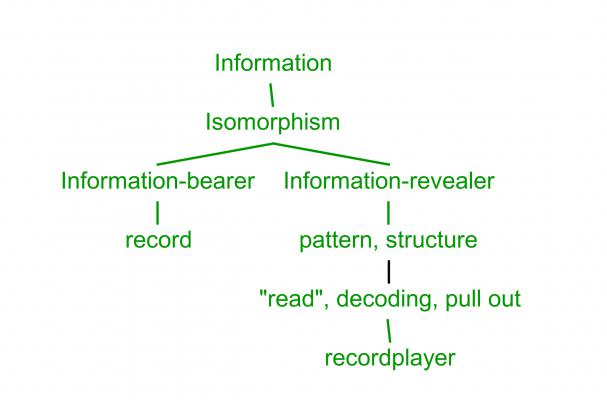
Quotes/Analysis:
--“…a record contains the same information as a piece of music, because of the existence of record players, which can ‘read’ records and convert the groove-patterns into sound…there is an isomorphism between groove-patterns and sounds, and the record player is a mechanism which physically realizes that isomorphism” (158). Hofstadter presents the analogy of a record and a record player in order to convey the concepts of information-bearer and information-receiver. The record player is the information-revealer because it decodes the information embedded (the music or sound) in the record. Hofstadter introduces one of his key terms used throughout the sections on information: isomorphism. Taking the term in context, isomorphism seems to indicate here that there is certain correspondence or relationship between the groove-patterns on the record and the sounds such that the information embedded in the groove patterns can be converted to sounds through the record player. The record player is the mechanism by which conversion/decoding takes place, and what allows the isomorphism between the groove-patterns and sounds to be realized. Hofstadter’s claim that that “a record contains the same information as a piece of music” reminded me of Professor Tian’s discussion about musical notation. Professor Tian’s mentioned that musical notation on its own is not music. Producing music necessitates the combination of notation and the performer who produces the auditory representation of the music. Within the context of Hofstadter’s claim, the notion of music and the information that is embedded within that music becomes even more interesting: the physical record (like the notation) contains the same information as the music itself. Like Professor Tian’s claim that the combination of notation and performer was needed, Hofstadter accounts for the auditory presentation through a combination as well, though he takes it a step further by incorporating another dimension to information: the record-player converts the groove-patterns into sound establish an isomorphic relationship between the two.
Decoding mechanisms = information-revealers.
“One gets the impression…that isomorphisms and decoding-mechanisms…simply reveal information which is intrinsically inside the structures, waiting to be ‘pulled-out’… [leading] to the idea that for each structure, there are certain pieces of information which can be pulled out of it, while there are pieces of information which cannot be pulled out of it” (158). The section ends with asking what it means to “pull-out”. Hofstadter reminds his readers that sometimes “pulling-out may involve such complex operations that it makes you feel you are pulling in more information that you are pulling out” (159).
What did the diagram effectively capture?
The diagram captured the proper relationship between the information-revealer and the record player, and the information-bearer and the record.
What did the diagram miss?
The diagram suggests an isomorphism between records (information-bearers) and record players (information-revealers). When in fact the isomorphism is between the record and the groove-patters (both information bearers).
Section: Three layers of any message
Words: decipherment, messages, levels, frame message, outer message, inner message, extracted, intended, meaning, decoding mechanism, info-bearer, recognize, symbol-patterns, structures, implicit message, set of triggers
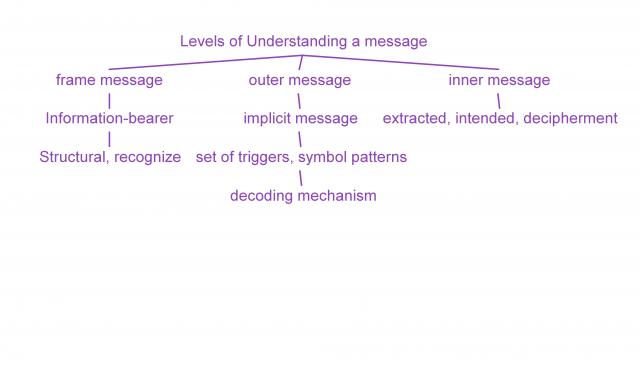
Quotes/Analysis:
1. The frame message: “I am a message; decode me if you can!”… “implicitly conveyed by the gross structural aspects of any information-bearer. To understand the frame message is to recognize the need for a decoding mechanism. If the frame message is recognized as such then attention is switched to level 2” (166).
2. The outer message- “This is information implicitly carried by symbol-patterns and structures in the message, which tells how to decode the inner message. To understand [this] is to build, or know how to build, the correct decoding mechanism for the inner message” (166).
--“outer level is an implicit message, in the sense that the sender cannot ensure that it will be understood…the outer message is necessarily a set of triggers, rather than a message that can be revealed by a known decoder” (166).
3. The inner message—“…the message which is supposed to be transmitted: the emotional experiences in music, the phenotype in genetics, the royalty and rites of ancient civilizations in tablets. To understand the inner message is to have extracted the meaning intended by the sender” (166).
--inner message can only be understood once the decoding mechanism has been found; the instructions for how to decode the outer message are part of the inner message.
Chapter 12: Minds and Thoughts
Section: Can minds be mapped onto each other?
Words: subsystems, brain, symbols, isomorphism, neural level, macroscopic suborgan level, map, triggering, patterns, functional isomorphism, thoughts, distinguishable vs. indistinguishable, communication, barriers, language, meaning, software, connecting
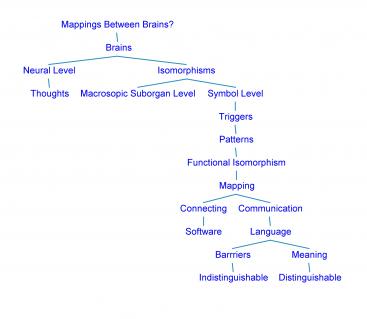
Quotes/analysis:
After having discussed in previous chapters the “existence of high-level active subsystems of the brain (symbols)”, Hofstadter turns to look at the notion of “a possible isomorphism, or partial isomorphism, between two brains” (369). Hofstadter claims that it is impossible to have an isomorphism on the neural level. The main question of this section asks about the “possibility of an isomorphism between brains on the symbol level: a correspondence which not only maps symbols in one brain onto symbols in another brain, but also maps triggering patterns onto triggering patterns” (369), where “the corresponding symbols in the two brains are linked in corresponding ways…a true functional isomorphism” (369).
Hofstadter is careful to clarify from the outset that such an isomorphism between two people does not exist because such correspondence would render the thoughts and memories of each virtually indistinguishable from one another, requiring that they shared the same life (which surely isn’t the case between people at present). He even points out that there isn’t a perfect isomorphic relationship, but rather an imperfect isomorphism even between our own present brains and our past brains: such as our brains ten years ago, and our brains now. The isomorphism between the past and present individual brain is so great that there are often profound disconnects between the present brain and the brain from five minutes before: if you really regret or are stunned at what you might have said five minutes earlier (369). This makes the isomorphisms between two separate individual brains even more unlikely.
However, on the other hand, Hofstadter is careful to note that there is often a great level of communication between very different people, arguing for some partial isomorphism between two separate brains, “…a correspondence of (1) the repertoire of symbols, and (2) the triggering patterns of symbols” (371).
The whole discussion revolves around the idea that it is possible to have a partial isomorphism—symbolic correspondence—between two different brains. Such an isomorphism—though partial—would tell us more about the organization and structure of higher level brain operations: thoughts. This discussion reminded me of Chorost’s notion of the World Wide Mind, in which all minds would be interconnected by the internet so as to have a greater understanding of one another’s thoughts and emotions, enhancing communication between people. Hofstadter claims that to understand one another’s brains is to understand our own brains.
What tree captured: The tree effectively mapped out the distinction between the neural level (non-isomorphic) with the macroscopic suborgan level and the symbol level (which can be partially isomorphic). The hierarchical arrangement of triggers, patterns, funneling down to a possible functional isomorphism seems to capture the general process of establishing an isomorphism (looking for triggers, finding patterns, etc.).
What tree missed: The connecting part of the tree is a bit arbitrary; communication could just as easily go there, leading to software. Also meaning is not always distinguishable.
Section: Comparing different semantic networks
Words: Partial isomorphism, network of symbols, triggers, patterns, picture, node, arcs, conceptual nearness, semantic network, interdependency of symbols, vertices, messages, neuron level messages, intertwining, links, representation, local properties, global properties
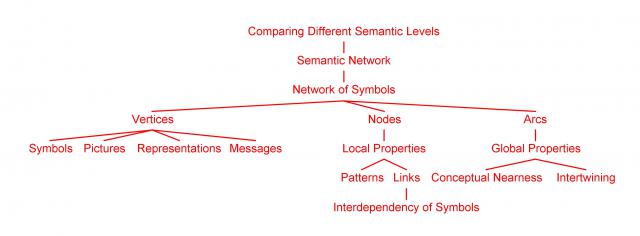
Quotes/analysis:
Hofstadter reflects that “no one has found an adequate way to represent the network of symbols and their triggering patterns”, making it difficult to define what exactly a partial isomorphism is. “Sometimes a picture of a small part of such a network of symbols is drawn, where each symbol is represented as a node into which, and out of which, lead some arcs. The lines represent triggering relationships—in some sense. Such figures capture the intuitively sensible notion of ‘conceptual nearness’. …the problem is that representing a complex interdependency of symbols cannot be carried out very easily with just a few lines joining vertices” (371). Additionally, with these semantic networks—which attempt to show the correspondence between two networks of thought—“it is not accurate to think of a symbol as simply ‘on’ or ‘off’” (371). Symbols are made up of many neurons making them more complex than individual neurons.
Hofstadter resolves to imagine that this issue is solved for the present moment in order to continue his analysis. He poses the supposition that there are “Certain drawings of nodes, connected by links…which capture precisely the way in which symbols trigger other symbols …” (371).
Hofstadter then moves onto local and global properties: “In any network-like structure, one can look at local properties and global properties. Local properties require only a very nearsighted observer—for example an observer who can only see one vertex at a time; and global properties require only a sweeping vision, without attention to detail” (371-372). Hofstadter helpfully provides the analogy of a spider web, where the general shape is a global property and the “average number of lines meeting at a vertex is a local property” (372). Supposing that to spider webs are isomorphic if they are spun by the same species, then we should ask what kind of observation, “local or global”, is more effective in establishing this isomorphism.
What tree captured: effectively captured the vertices section (symbols, pictures, representations, and messages) and the nodes (which are local properties) as patterns and links showing the interdependency of symbols.
What tree missed: Both the vertices and the arcs are also local properties. Even close-reading wasn’t quite enough—had to look to the following section for clarification:
Section: High-level comparisons between brains:
*This section was added to help clarify the findings from the previous section. It was read in full in order to get a comprehensive, thorough presentation 382—to help clarify previous
Hofstadter: “are people’s brains also capable of being ‘read’, on a high level? Is there some objective description of the content of a brain?” “Certainly the answer must be yes, since we are all quite able to describe, in chunked…terms, the activity of our minds at any given time. This means that we have a mechanism which allows us to chunk all of the brain state—we only chunk those portions which are active” (though we can quickly activate the dormant parts) (382). This discussion reminds me even more of Chorost as it brings in the question of “reading” another mind. Hofstadter uses this term carefully—not in the science fiction way—and asks whether there is an “objective description” of the “content” in a brain. He posits that there must be because we are able to describe the present activity of our own minds: “if a person can provide a chunked description of any part of his own brain, why shouldn’t an outsider too, given some nondestructive means of access to the same brain, not only be able to chunk limited portions of the brain, but actually to give a complete chunked description of it—in other words, a complete documentation of the beliefs of the person whose brain is accessible?” (382)
Again, this question is so important because if we want to understand ourselves (382). We are looking for a high-level description of the brain, not merely a neural level.
Chapter 20: Strange-Loops, or Tangled Hierarchies:
Section: Can machines possess originality?
Words: Machines, hardware, people, lowest-level rules, embedded, run, closed loop, infinite regress, computer, design, need, want, will/choice, physical, self-programmed object, program, reason, software
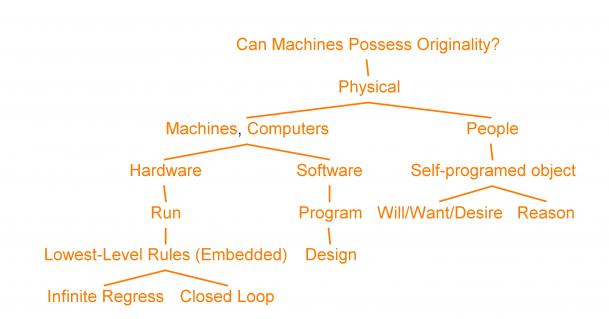
Quotes/Analysis:
Hafstadter challenges the “Reasoning is infinite regress argument”, in a rebuttal to an article by Arthur Samuel which upholds this logic of infinite regression. Samuel argues that machines cannot possess consciousness because “any mechanical instantiation of will would require infinite regress” (684-685).
Hofstadter’s argument: “the conclusion ‘Reasoning is impossible’ does not apply to people” because people do in fact reason on a daily basis, while also showing that humans function “without need of rules: we are ‘informal systems.’” The argument against mechanical instantiation of reason: “any mechanical reasoning…would have to depend on rules explicitly, and…couldn’t get off the ground unless it had metarules telling it when to appply its rules, and metametarules telling it when to apply its metarules… We must conclude that the ability to rason can never be mechanized. It is a uniquely human capability.” 685
The fallacy: “the assumption that a machine cannot do anything without having a rule telling it to do so.” As Hofstadter claims, both machines and people are comprised of hardware which runs by itself, “according to the laws of physics…the lowest-level rules—those without any ‘meta’s’ in front—are embedded in the hardware, and they run without permission” (685).
Conclusion: “Reasoning is mechanizable”.
Hofstader questions where will comes from, claiming: “you aren’t a self-programmed object’…but you still do have a sense of desires, and it springs from the physical substrate of your mentality” (685). Hofstadter’s conclusion: “Machines may someday have wills…for much the same reason as we do—by reason of organization and structure on many levels of hardware and software” (686).
What the tree missed: People are NOT self-programed objects. The depiction of the hardware level for machines follows the Samuel argument (which Hofstadter opposes). Both people and machines have hardware and software components.
Section: Below every tangled hierarchy lies an inviolate level
Words: Formal-rules, many-leveledness, mind/brain, rules, lowest-level, hardware, software rules, mental rules, think, software flexibility, mechanisms of intelligence, self-modifiable software, inviolate hardware, invariant core, variations, communicate, image, intangible intuitions
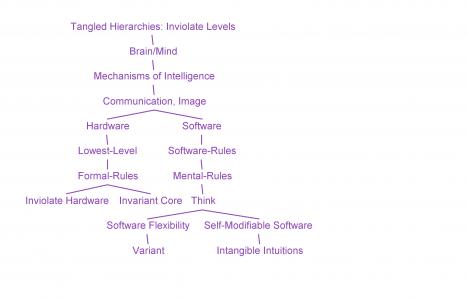
Quotes/Analysis—Close-reading:
686: The mechanisms of intelligence: neurons hardware level, thoughts software level; self-modifiable software and inviolate hardware
Hofstadter looks at the notion that words and thoughts follow formal rules: “…I have tried to show why the ultimate answer to the question [‘do words and thoughts follow formal rules’] is ‘yes’—provided that you go down to the lowest level—the hardware—to find the rules” (686).
When we think we do “change our own mental rules, and we change the rules that change the rules…but these are…‘software rules’…the rules at the bottom do not change. Neurons run in the same simple way the whole time...you have access to your thoughts, but not to your neurons. Software rules on various levels can change; hardware rules cannot—in fact, to their rigidity is due the software’s flexibility…not a paradox…but a fundamental, simple fact about the mechanisms of intelligence” (686)
Hofstadter wishes to examine the “distinction between self-modifiable software and inviolate hardware…[and find] an invariant core in all the variations” (686).
--Aim: “communicate images which help me to visualize how consciousness rises out of the jungle of neurons; to communicate a set of intangible intuitions…” (686).
What tree conceptually captured: For the most part the organization of hardware and software is captured accurately.
What tree missed: Some of the organization before the hardware/software distinction is arbitrary, if not inaccurate.
Escher’s Drawing Hands
Quotes/analysis/close-reading:
Left hand draws a right hand while the right hand draws the left hand; “levels which are ordinarily seen as hierarchical… turn back on each other, creating a Tangled Hierarchy...behind it all lurks the undrawn but drawing hand of M.C. Escher, creator both of LH and Rh. Escher is outside of the two-hand space.” The strange loop or tangled hierarchy is the seemingly paradoxical state of the RH drawing the LH while the LH draws the RH. This level is visible to the perceiver. The inviolate level refers to the level which is invisible (the hand of Escher drawing the two hands), which enables the tangled hierarchy to come into being. This notion of a tangled hierarchy is central to Hofstadter’s argument.
This was short so it was best to just read it in full, to hyper-read seemed almost more difficult; the assemblage of words would fail to reveal any significant pattern that could not be just as effectively gleaned through a conventional reading.
Section: Brain and mind—a neural tangle supporting a symbol tangle
Words: Brain, AI programs, thoughts, symbols, activate, interact heterarchically, inviolate substrate, software tangle, hardware tangle/neural tangle, neurons, symbol tangle, hierarchical levels, strange loops, in/on/outside a system, self-programmed object, illusion.
![]()
Quotes/analysis:
Hofstadter: “In our thoughts symbols activate other symbols, and all interact heterarchically…the symbols may cause each other to change internally, in the fashion of programs acting on other programs. The illusion is created because of the Tangled Hierarchy of symbols, that there is no inviolate level” (691) (However, we think that there is no such thing as an inviolate level precisely because we cannot see it) (691).
Hofstadter’s hypothetical schematized image of the mind is a: “gigantic forest of symbols linked to each other by tangy lines like vines in a tropical jungle—this would be the top level, the Tangled Hierarchy where thoughts really flow back and forth. This is the elusive level of mind: the analogue to LH and RH” (391).
The neurons are a tangle because there are “billions of cells and hundreds of billions of axons, joining them all together”, however, “only the symbol tangle is a tangled hierarchy…neural tangle is a ‘simple tangle’” (391).The hardware tangle (neurons) supports the software tangle (symbols). As mentioned in the previous section: “A Tangled Hierarchy occurs when what you presume are clear hierarchical levels take you by surprise and fold back in a hierarchy-violating way” (391)
Hofstadter: “Where language does create strange loops…it talks about itself, whether directly or indirectly. Here something in the system jumps out and act on the system, as if it were outside the system…what bothers us is… an ill-defined sense of topological wrongness: the inside-outside distinction is being blurred…even though the system is an abstraction, our minds use spatial imagery with a sort of mental topology” (691). If we “fall for the illusion” of Drawing Hands by forgetting the “existence of Escher” “then we seem to see a self-drawn project in much the same way that we see a “symbol tangle” if we “forget the neural tangle, then we seem to see a self-programmed object.” As humans “we feel self-programmed”(692) because we cannot see the lower levels, the “neural tangle”.
What tree captured: the resemblance between the hardware/structure organization of the brain and the machine.
What missed, what terms were clarified: symbols is not a self-programming object, also the tangles themselves (neural and symbol) were clarified with the close reading.
Section: An Escher vortex where all levels cross
Words/phrases: Print Gallery, young man stands, looks at picture of ship in harbor, boy sits on roof of building, woman gazes window below, sits above picture gallery, where young man stands, looks…
![]()
Quotes/analysis:
We see “a picture gallery where a young man is standing, looking at a picture of a ship in the harbor of a small town…[on a roof] sits a boy…while two floors below him a woman..gazes out of the window from her apartment which sits directly above the picture gallery, where a man is standing, looking at a picture of a ship in the harbor of a small town… What!?” “we are back on the same level as we began, though logic dictates that we cannot be.” 715
The tree effectively captured the direction/flow of relationships between the young man and the print gallery. The picture’s paradox is captured with the recurrence of the Print Gallery which shows the hierarchy come back on itself, circulating infinitely.
Words: Three kinds of “in-ness”, physically in town (inclusion), artistically in picture (depiction), and mentally in person (representation), arbitrary leve/division markers, collapsed schematic, paradox, inside itself, self-reference, two-step diagram, vortex, being outside the system, Escher’s signature as the central blemish
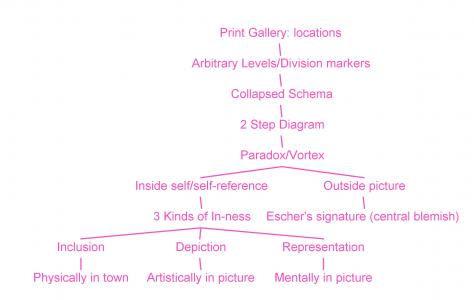
Quotes/analysis:
Hofstadter’s analysis: “the gallery is physically in the town (‘inclusion’); the town is artistically in the picture (‘depiction’); the picture is mentally in the person (representation)” (715), yet the gallery can also be seen to be artistically in the picture.
Further paradox of the picture: the picture is inside itself, which begs the question: “is the young man inside himself?” (716)
Are we “sucked into ourselves by virtues of looking at it? Not really. We manage to escape that particular vortex by being outside the system.” “When we look at the picture we see things that the young man…cannot…such as Escher’s signature, ‘MCE’…the central blemish….that center of the whorl is—and must be—incomplete” (716). Since we’re on the outside we know that the picture is incomplete which the man can never know.
What tree captured: the three types of “in-ness” and the fact that Escher is outside the picture, indicated by his signature.
What missed: the fact that we too are outside the picture because we can see what the young man cannot. Arbitrary arrangement of “divisions/markers”, “collapsed schema”, “2-step diagram”, and “paradox/vortex”.
Conclusions/Reflections:
Overall, though enormously dense, the organization of Gödel, Escher, Bach allowed for an exercise in hyper-reading: the books is divided into clear sections designated by headings which capture the gist of the section. Looking through the book for sections most pertinent to this semester in GIST was an exercise in hyper-reading itself because I had to sift quickly, yet effectively through this large volume. The tree diagrams had several limitations: it was difficult to frame an argument in them and show the building of ideas and the complicated embedment of ideas within ideas. However, there definitely was a benefit to the combined approach of hyper and close reading. The hyper-reading, collection of terms, and tree diagramming primed me ahead of time for key terms and concepts and the order they would be presented before close-reading. Often even the hierarchical structure of the tree diagrams helped me to visualize the structure and organization of concepts ahead of time in a way that I could not have done if I stuck to traditional close reading, where I would be bogged down in the concepts themselves and not aware of their structure.
The exercise overall allowed me to expand my knowledge of information and added another dimension to this complex topic. I was able to use the previous concepts and topics covered in conjunction with the new information. I saw a number of connections to readings from throughout the semester, most notably, Hayles’ piece on the digital humanities. Also the tangled hierarchies evoked Barad’s entanglement and Haraway’s diminishment of boundaries. Both of these authors presented concepts that challenged the previous structural organization of ideas, symbols, subjective and objective thoughts, etc. Hofstadter’s analogy between human and machine—the way humans think and machines think—reminded me of the cyborg question as well (part human, part machine).
Ultimately I do think that to really get the most out of this profound book, the reader must study closely and read in full. That said, it was still a good book to pick for this activity—sections really pertained to the course. Also, I chose this reading partly because it is difficult and demanding; the conceptual level complicates the task of hyper-reading the text. At the same time however, the parts of the book which are purely scientific, theoretical, philosophical analysis do abound with key terms and phrases which do tend to jump out during the process of hyper-reading. I found the experience of close-reading afterwards to be more rewarding because I was able to identify patterns and consistencies between the reading approaches while adding another dimension to my exposure and subsequent interpretation of the concepts presented.
Works Cited
Hofstadter, Douglass R.. Gödel Escher Bach: An Eternal Golden Braid. New York, Basic Books, 1999.



Comments
Kudos
Thank you for this article.
Bravo!!!!!
I have read it through once! and bits at different times and amount of effort you must have put in to write this analysis is enourmous!! His "I am a strange loop" is far more personal (after the loss of his wife) and easier to comprehend but tugs at your gut...
Again Bravo!!
#R;